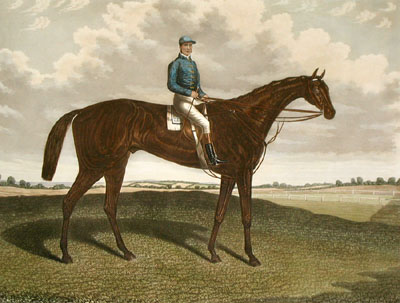
"Kisber" (1876)
Ref: TR-V409
Anonymous artist / engraver.
Size 24 x 31 inches. Ref V409. (approx 61 x 79 cms.)
The Baltazzis sent Kisbér to England to train and race, under the direction of Joseph Hayhoe, who trained the English horses owned by Mayer and Leopold de Rothschild. Some time during his juvenile season Kisbér began to suffer from a version of arthritis or rheumatism in his joints -- he "had to be hunted around his box to take the stiffness out of his joints before he was brought out to exercise of a morning." He was carefully nursed to race in only the most prestigious of the three-year-old races. He ran seven times, four of them as a juvenile.
Kisbér, running unamed as the "Mineral colt," went to the post four times at age two. "Very backward," he did not place in his two races at Newmarket July. In a private trial, where Kisber easily beat Baltazzi's good horse Coeruleus (by Beadsman; a winner of the Great Eastern Railway Handicap and the Great Shropshire at Shrewsbury), giving him "lumps of weight," he figured prominently in the betting prior to the Middle Park Plate, with Baltazzi wagering heavily on him to the maximum allowed by the bookmaker. But, he ran unplaced in that race, won by the beautiful and talented, but erratic, Petrarch in his only juvenile outing, with the filly Madeira second. There was speculation that his rheumatism had flared up, unnoticed by Hayhoe. Another private trial, held after the Middle Park Plate, showed Kisbér to be far superior to a filly by Gong, that had been beaten by a neck and a nose into third place in the Prendergast Stakes; in the trial he "gave her two stone and a good beating." At Newmarket Houghton he was the surprise winner of the Dewhurst Plate, beating the favored Springfield by three lengths. It was no surprise to Baltazzi and his friends, with whom he had shared the results of his amazing trial against the Gong filly, and Baltazzi recouped all he had lost in wagering on Kisbér in the Middle Park Plate.
Kisbér was withheld from the Two Thousand Guineas (won easily by Petrarch), so his first public appearance at age three was at Epsom, where Petrarch was a warm favorite for the Derby. In the meantime, Baltazzi had run up a large debt with a moneylender who theatened to seize Kisbér and prevent his running in the Derby. Sam Lewis, another money-lender settled the debt that allowed Kisbér to run and provided an additional £500. Baltazzi was told there was a superstition that unnamed horses running in the Derby "were always dogged by ill-luck," and so a few days before the Derby, the Mineral colt, after some debate, was named after the place of his birth.
Kisbér won the Derby easily by five lengths -- one of the more dramatic endings to a Derby -- with two moderate horses, Forerunner and Julius Caeser (the latter second to Petrarch in the Two Thousand Guineas) coming in second and third, Petrarch trailing eleven lengths from the winner in fourth place, and the rest of the field behind him. It was an enormous upset, in every sense of the word. Kisbér was the first foreign-bred horse to win the Derby since the great Gladiateur had triumphed in 1862. Word of his triumph electrified the racing world in Vienna and Hungary. Baltazzi and his brothers reportedly cleared £100,000 in bets on the race.
